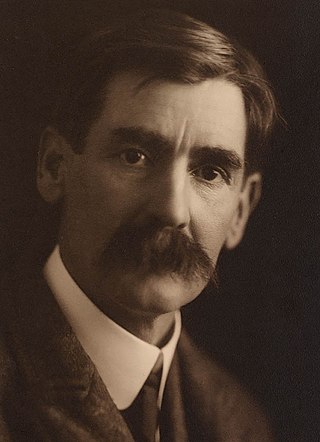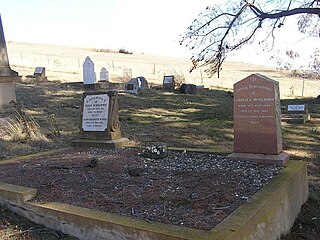
"Waltzing Matilda" is a song developed in the Australian style of poetry and folk music called a bush ballad. It has been described as the country's "unofficial national anthem".

Andrew Barton "Banjo" Paterson, was an Australian bush poet, journalist and author. He wrote many ballads and poems about Australian life, focusing particularly on the rural and outback areas, including the district around Binalong, New South Wales, where he spent much of his childhood. Paterson's more notable poems include "Clancy of the Overflow" (1889), "The Man from Snowy River" (1890) and "Waltzing Matilda" (1895), regarded widely as Australia's unofficial national anthem.

Henry Archibald Hertzberg Lawson was an Australian writer and bush poet. Along with his contemporary Banjo Paterson, Lawson is among the best-known Australian poets and fiction writers of the colonial period and is often called Australia's "greatest short story writer".

"The Man from Snowy River" is a poem by Australian bush poet Banjo Paterson. It was first published in The Bulletin, an Australian news magazine, on 26 April 1890, and was published by Angus & Robertson in October 1895, with other poems by Paterson, in The Man from Snowy River and Other Verses.
"Clancy of the Overflow" is a poem by Banjo Paterson, first published in The Bulletin, an Australian news magazine, on 21 December 1889. The poem is typical of Paterson, offering a romantic view of rural life, and is one of his best-known works.
Kilmeny Niland was a New Zealand–born Australian artist and illustrator. While best known for her children's book illustrations, she worked in a wide range of genres, including animation, wildlife art, miniatures, portraits, cards and prints. She won numerous prizes in national and international competitions, and one of her portraits was purchased by Australia's National Portrait Gallery, in Canberra.
The Man from Snowy River: Arena Spectacular, based on Banjo Paterson's poem The Man from Snowy River, was a popular musical theatre production which toured Australian capital cities twice during 2002. Kevin Jacobsen and David Atkins were the executive producers for the show. David Atkins and Ignatius Jones were co-directors and co-writers. Extra dialogue was written for the show by Jonathan Biggins and Phillip Scott.

The Man from Snowy River is a 1982 Australian Western drama film based on the Banjo Paterson poem "The Man from Snowy River". The film had a cast including Kirk Douglas in a dual role as the brothers Harrison and Spur, Jack Thompson as Clancy, Tom Burlinson as Jim Craig, Sigrid Thornton as Harrison's daughter Jessica, Terence Donovan as Jim's father Henry Craig, and Chris Haywood as Curly. Both Burlinson and Thornton later reprised their roles in the 1988 sequel, The Man from Snowy River II. The 1988 sequel film was later released in the United States by Walt Disney Pictures under the title Return to Snowy River and in the United Kingdom under the title The Untamed.

Charles Lachlan "Charlie Mac" McKeahnie was an Australian horseman born in Gudgenby, ACT to Alexander and Mary McKeahnie into a family of five sisters. He is believed by some historians to be the inspiration for the poem 'The Man from Snowy River' by Banjo Paterson.

Eaglehawk is a suburb within the City of Greater Bendigo and a former gold-mining town in Victoria, Australia.

Cycling in Sydney, New South Wales, Australia takes place for recreation, commuting and as a sport. Sydney has a hilly topography and so may require a slightly higher level of fitness from cyclists than flatter cities such as Melbourne and Canberra. Sydney depends heavily on motor vehicles where traffic and public transport operate at capacity. This means that cyclist are often competing with motorists for limited space on busier roads, and for limited government resources for expenditure on road infrastructure. In its favour, Sydney has a generally mild climate and there are active cycling groups.
Cycling in the Australian state of Victoria is a popular pastime, sport and way of getting around since at least 1896, as indicated by the Banjo Paterson poem Mulga Bill's Bicycle. Cycling in Victoria has been encouraged by the development of bicycle networks in town and cities throughout the state, and many regional rail trails. The sports popularity has been encouraged by the success of racing clubs such as the St Kilda Cycling Club and Victorian racing riders such as Cadel Evans, Simon Gerrans and Matthew Lloyd. Organised rides held annually including the Great Victorian Bike Ride, and races held in Victoria include the Herald Sun Tour.
Hay and Hell and Booligal is a poem by the Australian bush poet A. B. 'Banjo' Paterson who wrote the poem while working as a solicitor with the firm of Street & Paterson in Sydney. It was first published in The Bulletin on 25 April 1896. The poem was later included in Paterson's collection Rio Grande's Last Race and Other Verses, first published in 1902.
Deborah Mary Niland is a New Zealand–born Australian artist, known as a writer and illustrator of children's books. Some of her most popular books include Annie's Chair, When The Wind Changed, Mulga Bill's Bicycle, and Chatterbox. In 2006 she won The Children's Book of the Year – Early Childhood, with her book Annie's Chair.

The Sydney Mail was an Australian magazine published weekly in Sydney. It was the weekly edition of The Sydney Morning Herald newspaper and ran from 1860 to 1938.
Rio Grande's Last Race is a racing poem by Australian writer and poet Andrew Barton "Banjo" Paterson. It was first published in the London Sketch magazine on 16 December 1896. It was later published as the title poem for Paterson's second poetry collection, Rio Grande's Last Race and Other Verses, in 1902.
Rio Grande's Last Race and Other Verses (1902) is the second collection of poems by Australian poet Banjo Paterson. It was released in hardback by Angus and Robertson in 1902, and features the poems "Rio Grande's Last Race", "Mulga Bill's Bicycle", "Saltbush Bill's Game Cock" and "Saltbush Bill's Second Fight".
Mrs Sarah Maddock (1860–1955) was an Australian endurance cyclist during the 1890s and early 1900s and the first woman to ride a bicycle from Sydney to Melbourne and later Sydney to Brisbane and back.









